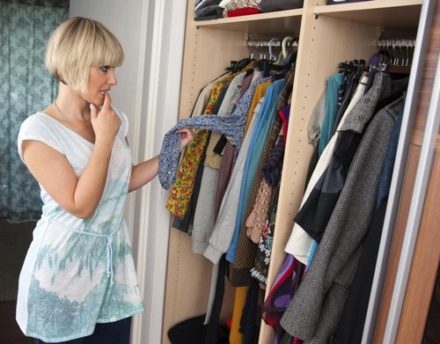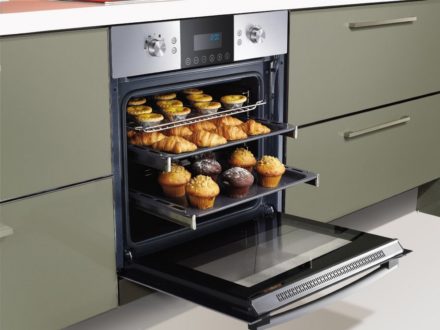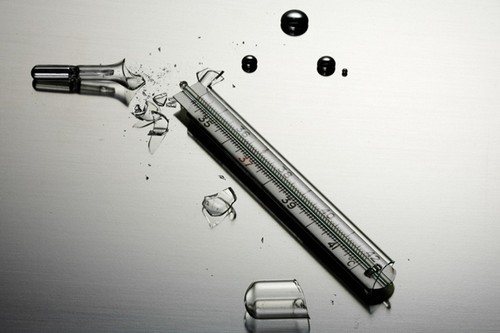The KonMari method: Japanese closet cleaning is part of a system of putting things in order not only in the closet, but also in life. This method was invented by the Japanese Marie Kondo and named after her after the first letters of her name. Her revolutionary method of cleaning very quickly captured the whole world under the slogan “Do you want to never do spring cleaning again in your life?” It is filled with Japanese philosophy, a “living” attitude to things, and communication with the Universe.

The main thread running through the entire method is the awareness that the things around us should please us and carry only a positive attitude. It differs from other algorithms for putting things in order (for example, from the flylady system) in that it is proposed to clear your closet of rubbish once, and then only maintain order.
The scale of the “tragedy”
According to the KonMari method, you need to take apart all of one person’s clothes at one time. Here's everything - from underwear to a down jacket. We collect all wardrobe items in one place, checking all the places where they may be located. This process is quite personal and is best done alone. Marie also advises starting to sort things out as early as possible in order to get it done in one day.
First, let's categorize everything:
- clothes that need to be stored on hangers - jackets, skirts, trousers, suits, coats, etc.;
- T-shirts, tops, sweatshirts, jumpers;
- underwear;
- socks and tights;
- special clothing - swimsuits, sports uniforms;
- shoes;
- bags;
- accessories - scarves, hats, belts, etc.
Getting rid of unnecessary things
Now, following the method, you need to “test” each item of clothing for positive emotions. You need to take each thing in your hands and understand whether it brings joy or not. This way we determine what to keep and not what to throw away. Vague criterion, isn't it? Well, what can please you, for example, is a sock. It turns out it can. At least because it is a beautiful color and not full of holes. Of course, some wardrobe items may be difficult. A classic trench coat may not bring joy, but it seems like it should be. In this case, Marie recommends asking yourself: am I ready to put this on myself again? If yes, leave it. If you doubt it even for a split second, we definitely throw the thing away.
Marie believes that every item has its own function, and before throwing it away or giving it away, one should thank it for its service. For example, if a thing doesn’t suit you, then its function was to teach you not to buy anything like it again - the same style or color.
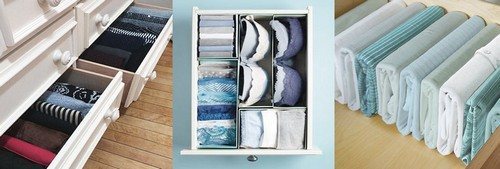
First of all, Marie recommends sorting out out-of-season clothes - summer clothes in winter and vice versa.
The main rule of the KonMari system: you cannot classify clothes for the home that you will no longer wear to work or “in public” (T-shirts are an exception). Firstly, because in the end the mountain of household goods will definitely grow, but it will not be worn. And secondly, according to Marie, the things we wear at home influence our self-image.
Perhaps not everyone is ready to immediately throw away good, strong things. Then a softer version of the system is offered.Those wardrobe items that did not evoke positive emotions should be put into boxes and offered to relatives or given to those in need.
According to the system, it is forbidden to impose on your loved ones what you want to give them. Perhaps your mother or friend will take the offered item because it will be inconvenient for her to refuse. But it will turn out to be unsuitable, it will lie idle and create a problem for them. You should leave for your loved ones only what suits them one hundred percent.
Marie Kondo writes that people usually get rid of a quarter or even a third of their wardrobe. Things bought for an occasion that never came are gone; gifts that for some reason you don’t like; bought at sales that don’t suit you, but it’s a pity for the money spent.
Whether the remainder will be enough for you or whether you will need to purchase something additional, you will understand intuitively. As Marie writes, something has to click in your head.
Proper storage of clothes
When only what is needed remains, we begin organizing storage. There are two storage methods: on hangers and on shelves or in drawers. Marie Kondo suggests mainly using the second method for storage, only storing things not in horizontal stacks, but in a vertical position. She recommends this for several reasons:
- saving space;
- when all the things are folded and fill the box from wall to wall, you will once again ask yourself the question, is it necessary to purchase another wish list if there is nowhere to put it;
- every time we touch wardrobe items, folding them, we endow them with our positive energy.
In order for clothes to be stored vertically, they must be folded correctly.Each item needs to be rolled into a small rectangle or rolled into a roll - like Japanese rolls. We put tops, T-shirts, shorts, jeans, and underwear into rectangles. We roll socks and tights into rolls. You can learn how to fold things using the KonMari method using schematic drawings or watching videos on YouTube. The number of folds is calculated as follows: the height of the edge-to-edge rectangle or roll should not exceed the height of the wall of the drawer or clothing box.
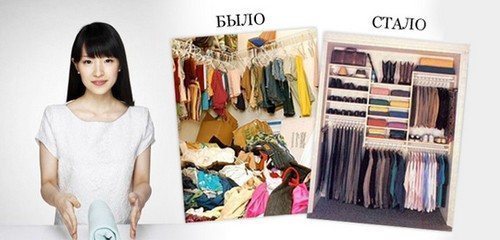
After this, we arrange the folded and rolled items in rows by category (socks to socks, panties to panties, sweaters to sweaters, etc.). With this layout there are two advantages: first, you can easily find what you need because it’s in plain sight, and second, when you take out one thing, the rest remains in its original position. When asked if clothes stored in this way wrinkle a lot, Marie replies that it doesn’t wrinkle much. Folded vertically, it wrinkles much less than when thrown just like that or lying in the usual pile.
Marie advises against purchasing special storage devices. You can make do with available items - plastic dividers, shoe or paper boxes, plastic baskets.
Hanging out the remaining things
In addition to folding clothes, Marie also gives tips on hanging clothes - suits, dresses, blouses, jackets and raincoats.
The main rule: you also need to hang it by type - blouses to blouses, trousers to trousers. Longer and heavier wardrobe items will be on the left, while lighter and shorter items will be on the right. It will look as if things are visually rising from left to right.Marie writes that wardrobe items arranged in this way will fill your home with positive energy and provide lightness and comfort.
We do not remove out-of-season clothing
Marie Kondo believes that there is no need to put away out-of-season clothes for storage. But this advice is not very suitable for Russia, it seems to me. We have too much temperature difference between seasons. In winter, we are unlikely to need shorts, and in summer we will definitely not wear a down jacket.
Bags
Marie Kondo recommends storing bags nested inside each other, after dividing them by purpose and material. You need to stack them in threes together with the handles facing out. This way they take up less space in the closet and are stored better.
The KonMari system really helps you organize your closet, you just have to decide to put it into practice. And the most important thing is to immediately return everything to its place after washing and ironing. Then your closet will be an example of Japanese order and minimalism, and most likely you will want to continue using this method.




